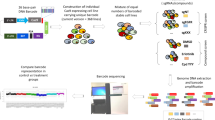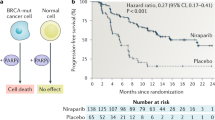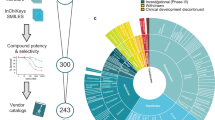Abstract
Genetic screens in cultured human cells represent a powerful unbiased strategy to identify cellular pathways that determine drug efficacy, providing critical information for clinical development. We used insertional mutagenesis-based screens in haploid cells to identify genes required for the sensitivity to lasonolide A (LasA), a macrolide derived from a marine sponge that kills certain types of cancer cells at low nanomolar concentrations. Our screens converged on a single gene, LDAH, encoding a member of the metabolite serine hydrolase family that is localized on the surface of lipid droplets. Mechanistic studies revealed that LasA accumulates in lipid droplets, where it is cleaved into a toxic metabolite by LDAH. We suggest that selective partitioning of hydrophobic drugs into the oil phase of lipid droplets can influence their activation and eventual toxicity to cells.
This is a preview of subscription content, access via your institution
Access options
Access Nature and 54 other Nature Portfolio journals
Get Nature+, our best-value online-access subscription
$29.99 / 30 days
cancel any time
Subscribe to this journal
Receive 12 print issues and online access
$259.00 per year
only $21.58 per issue
Buy this article
- Purchase on Springer Link
- Instant access to full article PDF
Prices may be subject to local taxes which are calculated during checkout






Similar content being viewed by others
Data availability
The complete lists of the hits from the genetic screens are given in Supplementary Data 1. RNA-seq data from Hap1 cells is freely available at NCBI GEO, under accession no. GSE75515. The GI50 data for LasA and the RNA-seq data for cancer cell lines is publicly available (accession numbers given in the appropriate Methods section). Software for analysis of screen results has been described previously9,10 and is freely available on github: https://github.com/RohatgiLab/BAIMS-Pipeline.
References
Horton, P. A., Koehn, F. E., Longley, R. E. & McConnell, O. J. Lasonolide A, a new cytotoxic macrolide from the marine sponge Forcepia sp. J. Am. Chem. Soc. 116, 6015–6016 (1994).
Wright, A. E. et al. Lasonolides C–G, five new lasonolide compounds from the sponge Forcepia sp. J. Nat. Prod. 67, 1351–1355 (2004).
Isbrucker, R. A., Guzman, E. A., Pitts, T. P. & Wright, A. E. Early effects of lasonolide A on pancreatic cancer cells. J. Pharmacol. Exp. Ther. 331, 733–739 (2009).
Zhang, Y. W., Ghosh, A. K. & Pommier, Y. Lasonolide A, a potent and reversible inducer of chromosome condensation. Cell Cycle 11, 4424–4435 (2012).
Josse, R. et al. Activation of RAF1 (c-RAF) by the marine alkaloid lasonolide A induces rapid premature chromosome condensation. Mar. Drugs 13, 3625–3639 (2015).
Trost, B. M. et al. Total synthesis of (−)-lasonolide A. J. Am. Chem. Soc. 138, 11690–11701 (2016).
Carette, J. E. et al. Haploid genetic screens in human cells identify host factors used by pathogens. Science 326, 1231–1235 (2009).
Carette, J. E. et al. Global gene disruption in human cells to assign genes to phenotypes by deep sequencing. Nat. Biotechnol. 29, 542–546 (2011).
Dubey, R. et al. Chromatin-remodeling complex SWI/SNF controls multidrug resistance by transcriptionally regulating the drug efflux pump ABCB1. Cancer Res. 76, 5810–5821 (2016).
Carette, J. E. et al. Ebola virus entry requires the cholesterol transporter Niemann–Pick C1. Nature 477, 340–343 (2011).
Simon, G. M. & Cravatt, B. F. Activity-based proteomics of enzyme superfamilies: serine hydrolases as a case study. J. Biol. Chem. 285, 11051–11055 (2010).
Bachovchin, D. A. & Cravatt, B. F. The pharmacological landscape and therapeutic potential of serine hydrolases. Nat. Rev. Drug Discov. 11, 52–68 (2012).
Hebenstreit, D. et al. RNA sequencing reveals two major classes of gene expression levels in metazoan cells. Mol. Syst. Biol. 7, 497–497 (2011).
Goo, Y. H., Son, S. H., Kreienberg, P. B. & Paul, A. Novel lipid droplet-associated serine hydrolase regulates macrophage cholesterol mobilization. Arterioscler. Thromb. Vasc. Biol. 34, 386–396 (2014).
Thiel, K. et al. The evolutionarily conserved protein CG9186 is associated with lipid droplets, required for their positioning and for fat storage. J. Cell Sci. 126, 2198–2212 (2013).
Marchler-Bauer, A. et al. CDD: NCBI’s conserved domain database. Nucleic Acids Res. 43, D222–D226 (2015).
Currall, B. B. et al. Loss of LDAH associated with prostate cancer and hearing loss. Hum. Mol. Genet. 27, 4194–4203 (2018).
Kory, N. et al. Mice lacking lipid droplet-associated hydrolase, a gene linked to human prostate cancer, have normal cholesterol ester metabolism. J. Lipid Res. 58, 226–235 (2017).
Olzmann, J. A. & Carvalho, P. Dynamics and functions of lipid droplets. Nat. Rev. Mol. Cell Biol. 20, 137–155 (2019).
Brasaemle, D. L. & Wolins, N. E. Isolation of lipid droplets from cells by density gradient centrifugation. Curr. Protoc. Cell Biol. 72, 3.15.1–3.15.13 (2016).
Banani, S. F., Lee, H. O., Hyman, A. A. & Rosen, M. K. Biomolecular condensates: organizers of cellular biochemistry. Nat. Rev. Mol. Cell Biol. 18, 285–298 (2017).
Greenwood, D. J. et al. Subcellular antibiotic visualization reveals a dynamic drug reservoir in infected macrophages. Science 364, 1279–1282 (2019).
Zheng, N., Tsai, H. N., Zhang, X. & Rosania, G. R. The subcellular distribution of small molecules: from pharmacokinetics to synthetic biology. Mol. Pharm. 8, 1619–1628 (2011).
den Brok, M. H., Raaijmakers, T. K., Collado-Camps, E. & Adema, G. J. Lipid droplets as immune modulators in myeloid cells. Trends Immunol. 39, 380–392 (2018).
Fowler, S., Shio, H. & Haley, N. J. Characterization of lipid-laden aortic cells from cholesterol-fed rabbits. IV. Investigation of macrophage-like properties of aortic cell populations. Lab. Investig. 41, 372–378 (1979).
Foley, P. Lipids in Alzheimer’s disease: a century-old story. Biochim. Biophys. Acta 1801, 750–753 (2010).
Delikatny, E. J., Chawla, S., Leung, D.-J. & Poptani, H. MR-visible lipids and the tumor microenvironment. NMR Biomedicine 24, 592–611 (2011).
Petan, T., Jarc, E. & Jusović, M. Lipid droplets in cancer: guardians of fat in a stressful world. Molecules 23, 1941 (2018).
Sundelin, J. P. et al. Increased expression of the very low-density lipoprotein receptor mediates lipid accumulation in clear-cell renal cell carcinoma. PLoS ONE 7, e48694 (2012).
Hager, M. H., Solomon, K. R. & Freeman, M. R. The role of cholesterol in prostate cancer. Curr. Opin. Clin. Nutr. Metab. Care 9, 379–385 (2006).
Aboumrad, M. H., Horn, R. C. Jr. & Fine, G. Lipid-secreting mammary carcinoma. Report of a case associated with Paget’s disease of the nipple. Cancer 16, 521–525 (1963).
Ramos, C. V. & Taylor, H. B. Lipid-rich carcinoma of the breast. A clinicopathologic analysis of 13 examples. Cancer 33, 812–819 (1974).
Rautio, J., Meanwell, N. A., Di, L. & Hageman, M. J. The expanding role of prodrugs in contemporary drug design and development. Nat. Rev. Drug Discov. 17, 559–587 (2018).
Ran, F. A. et al. Genome engineering using the CRISPR-Cas9 system. Nat. Protoc. 8, 2281–2308 (2013).
Sanjana, N. E., Shalem, O. & Zhang, F. Improved vectors and genome-wide libraries for CRISPR screening. Nat. Methods 11, 783–784 (2014).
Campeau, E. et al. A versatile viral system for expression and depletion of proteins in mammalian cells. PLoS ONE 4, e6529 (2009).
Trost, B. M. et al. A concise synthesis of (−)-lasonolide A. J. Am. Chem. Soc. 136, 88–91 (2014).
Acknowledgements
We thank D. Herschlag for bringing the LasA project to our attention, C. Pataki and R. Kopito for comments and advice on lipid droplet fractionation experiments and A. Lebensohn for advice on the project. The work was funded by DP2 GM105448 (R.R.), R35 GM118082 (R.R.), DP2 AI104557 (J.E.C.), American Heart Association Transformational Research Projects no. 18TPA34230103 (A.P.) and no. 18TPA34230086 (Y.-H.G.), and Dominic Ferraioli Foundation (A.P.). R.R. is a Josephine Q. Berry Faculty Scholar in Cancer Research at Stanford, J.E.C. is a David and Lucile Packard Foundation fellow and R.D. was supported by fellowships from the Stanford Dean’s Fund and Alex’s Lemonade Stand Foundation.
Author information
Authors and Affiliations
Contributions
R.R. and R.D. designed the project. B.M.T. and C.E.S. designed and synthesized LasA, LasF, Ces-73, Ces-24a and Ces-24b. R.D. and J.E.C. executed the haploid genetic screens. R.D. and H.Q.N. performed the mass spectrometry experiments. R.D., A.P. and Y.-H.G. designed and constructed the LDAH variants. R.D. performed all other experiments and analyses presented in the paper. R.R. and R.D. wrote the paper and all the authors edited and commented on the paper.
Corresponding author
Ethics declarations
Competing interests
The authors declare no competing interests.
Additional information
Publisher’s note Springer Nature remains neutral with regard to jurisdictional claims in published maps and institutional affiliations.
Supplementary information
Supplementary Information
Supplementary Figs. 1–12.
Supplementary Video 1
Movie of live Hap1 cells expressing LDAH-GFP.
Supplementary Data 1
Compiled data from the haploid screens (see Fig. 1c and Supplementary Figs. 1 and 2a).
Rights and permissions
About this article
Cite this article
Dubey, R., Stivala, C.E., Nguyen, H.Q. et al. Lipid droplets can promote drug accumulation and activation. Nat Chem Biol 16, 206–213 (2020). https://doi.org/10.1038/s41589-019-0447-7
Received:
Accepted:
Published:
Issue Date:
DOI: https://doi.org/10.1038/s41589-019-0447-7
This article is cited by
-
Lipid droplets: a cellular organelle vital in cancer cells
Cell Death Discovery (2023)
-
Involvement of cell shape and lipid metabolism in glioblastoma resistance to temozolomide
Acta Pharmacologica Sinica (2023)
-
The expanding organelle lipidomes: current knowledge and challenges
Cellular and Molecular Life Sciences (2023)
-
Chain flexibility of medicinal lipids determines their selective partitioning into lipid droplets
Nature Communications (2022)
-
Tumour fatty acid metabolism in the context of therapy resistance and obesity
Nature Reviews Cancer (2021)



